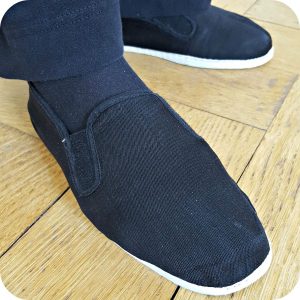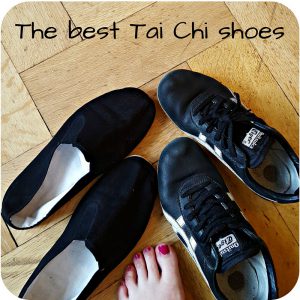How to choose the best Tai Chi shoes
When I started learning Tai Chi in 2004, I went to a school where it was not allowed to practice barefoot. So I started my quest to find the best Tai Chi shoes.
I will talk you through the different options I’ve tried and I am sure you will find your best Tai Chi shoes, too! Just click on the pictures and you will be lead to Amazon so you don’t have to search for them.
Choosing the best Tai Chi shoes
In the very early beginning of my Tai Chi practice I did train in socks. And I still recommend them if you do only Qi Gong or if you just started. But just socks felt somehow “slippery” to me.
Then I tried these socks with the little rubber things on them. However, I feel uncomfortable to make turns or sliding steps in them. They will simply stop – that’s what they are supposed to do!
Thus I really prefer to wear shoes for Tai Chi to feel more grip. To me, wearing shoes to practice is also like a small ritual: I put on my shoes and I know “now it’s practice time”. For practicing Taijiquan indoors I like to wear fabric Tai Chi slippers like these:

The advantage of Tai Chi slippers* is that they are quite cheap. You can get them at Amazon or in many Chinese shops. They are light weight and you instantly look like a “pro” 😉 ! However, they have no rubber or anything on the sole so they are a bit slippery. Don’t ask me why, but after a couple of weeks they won’t feel that slippery anymore. Another reason to practice daily!
And I would not recommend to wear the Tai Chi shoes with the cotton sole in the park or in grass because your feet might get wet.
If you want more grip, these simple shoes are also available with a rubber sole.

However, I prefer the ones with the cotton sole. My feet are less sweaty in them and I personally do not like to wear rubber soles inside.
And I would not recommend to practice outdoors with them either because the fabric would get wet (unless you only practice in the sunshine anyway!).
IF you like an even fancier version, have a look at these shoes:

If you would like to have even more grip and more foothold you could choose some of these Tai Chi shoes (click on the picture to see them on Amazon):

They have a rubber sole for more grip. As you can tie them they give you more foothold.
You can use these shoes for Tai Chi outdoor, too. Just remember that if you want to use them in- & outdoor ask you teacher if that is ok. Some do not like to have outdoor shoes in their indoor training place!
However, I personally do not wear this footwear, because when I train indoors I prefer the light weighted fabric version.
And outdoors I have to admit that I prefer a more “subtle” version. But I usually bring my children to their daycare and practice in the park after that. I simply do not like to wear “fighting” shoes when going to primary school! So for practicing in the park etc. these are my best Tai Chi shoes:

The Onitsuka Tiger Tai Chi shoes* are basically training shoes with a thin sole. They are very comfortable and you can wear them “in normal life” as well as on the training ground! I bought mine many years ago. They are hard to get, but if you find them, I really recommend them! (fun fact: the Onitsuka Tiger Tai Chi shoes in yellow were worn by Uma Thurman in the movie “Kill Bill)
Now you might wonder: why can’t I wear normal athletic shoes to practice Taijiquan and Qi Gong? If you really need a lot of foothold it might even be an option in the very beginning. But with such thick soles it is not quite possible to role your feet. You are simply not that sensitive with a thick layer of rubber clasping around your feet and toes!
Additionally, Tai Chi and Qi Gong are both great practices to train your feet. Give them a rest and do not surround them with that much rubber and fabric all the time! Walk and train barefoot whenever you can. Your feet will get stronger and more flexible and it is just a nice feeling to let them breathe and feel the ground!

And when you need shoes or want more support, I have found that the simple black shoes with cotton sole* and the Onitsuka Tiger Tai Chi shoes* are my best Tai Chi shoes!
Happy Qi!
Angelika
Comments are closed.


16 Comments
Nice site Angelika. Regards, Peter
thank you!
i feel the slipperiness of the cotton-soled shoes is an instructional advantage because it tells you if your weight is being directed straight down or not. If you are slipping, you are leaning, not vertical. They also render the spins and foot adjustments less effortful. I too am enjoying your site, Angelika.
thank you for your comment and that you like my site!
yes, the slipperiness can also be an advantage! Good point.
Angelika
Shoes are useful especially when outside in the cold, but barefoot is best at the start not only can you see the foot as the instructor but you can direct others to observe their and fellow ‘s feet and this creates awareness of weight shifts and so on.
I use both cotton soled and rubber soled shoes and do it barefoot indoors and in summer.
Note where a person’s knees point in the various stances as this needs to be correct to avoid knee damage later on, especially if the stances are very low as this means a lot of weight on the joint if incorrectly positioned. My dear friend Coleman Fink who introduced me to Tai chi in the 1970’s and teaches out near Cape Cod (USA) has a lot to say about this having taught for the past 30 years. He can be found on Google+
I agree, I think it’s a good idea to practice in shoes as well as barefoot!